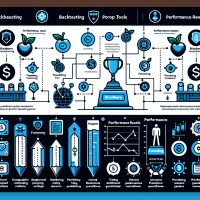Introduction: Embracing Real-Market Challenges in Prop Trading
Proprietary trading is evolving, driven by technologies that enable in-depth backtesting and real-time performance metrics. In today’s competitive landscape, prop trading firms are increasingly relying on evaluation programs that mimic real-market conditions. The Blueberry Funded program, with its real-market challenges, is one such innovative approach that compels traders to adapt quickly and refine their strategies. In this guide, we will delve into alternative evaluation methods, advanced backtesting concepts, and the proper integration of risk management practices tailored for prop trading.
In light of regulatory frameworks like MiFID II and ESMA directives, firms are faced with the additional complexity of compliance requirements. This article is designed for a range of professionals—from junior traders to senior quants and risk managers—highlighting actionable insights and comparisons of popular backtesting tools to help you achieve a sharper trading edge.
Understanding Blueberry Funded and Prop Trading Evaluations
The Blueberry Funded evaluation program is designed to simulate real-market conditions, ensuring that traders are not just backtesting strategies in a vacuum but are fully prepared for live market scenarios. Key features include broker-backed payouts and stringent performance metrics such as Sharpe ratios and maximum drawdown limits. This section explains the importance of aligning prop trading strategies with robust backtesting and real-world validation to minimize pitfalls like overfitting and data snooping.

Figure 1: Backtesting report screenshot from TradingView illustrates key performance metrics such as Sharpe Ratio and drawdown, providing a clear picture of strategy robustness.
Comparative Analysis of Automated Backtesting Tools
Successful prop trading requires the effective use of automated backtesting tools capable of handling real-time data, optimizing parameters, and integrating with broker platforms. Below is a detailed comparison of three widely recognized tools:
TradingView
Backtesting Features: TradingView offers vectorized backtesting, though it is primarily suited for charting and simple script automation with Pine Script. It handles commissions and slippage, and while optimization options are available, they are not as advanced as some dedicated platforms.
Data & Integration: Known for high-quality, extensive historical data across multiple asset classes, TradingView integrates seamlessly with various brokers and social trading networks.
Pricing & Use Cases: With tiered subscriptions (including free and pro versions), TradingView is ideal both for retail traders and for prop firms needing quick, visual insights.
MetaTrader 5 (MT5)
Backtesting Features: MT5 supports event-driven backtesting, accommodating detailed commission structures and slippage. Its optimization engine facilitates automated parameter optimization and stress testing.
Data & Integration: Backed by extensive historical data, MT5 offers real-time feeds and a robust API for integration with external analytics tools, making it suitable for both individual and institutional settings.
Pricing & Use Cases: MT5 is freely available through many brokers, and its advanced algorithmic capabilities support deep diversification strategies with extensive team collaboration features in a firm environment.
NinjaTrader
Backtesting Features: NinjaTrader is renowned for its advanced backtesting capabilities with both historical and real-time analysis. Its features include detailed scenarios analysis, parameter optimization, and comprehensive report generation.
Data & Integration: It provides access to high-quality historical tick data and integrates well with third-party analytics and broker platforms. Its API and plugin support further solidify its place in advanced prop trading setups.
Pricing & Use Cases: With competitive pricing and trial versions available, NinjaTrader is well-suited for firm-level deployment where scalability and collaborative trading strategies are paramount.
Advanced Backtesting Techniques for Prop Trading
As the prop trading landscape becomes more sophisticated, understanding advanced backtesting techniques is essential. This section covers common pitfalls, the benefits of walk-forward optimization, the critical role of out-of-sample testing, and seamless integration with forward testing environments.
Avoiding Common Backtesting Pitfalls
Many traders run into challenges such as overfitting, survivorship bias, and look-ahead bias. To mitigate these issues, consider the following practices:
- Use separate data sets for training and testing to avoid data snooping.
- Implement robust error-checking algorithms to ensure data integrity.
- Regularly update data sources to reflect the most current market conditions.
Walk-Forward Optimization vs. Traditional Backtesting
Walk-forward analysis allows traders to use rolling windows of data for testing strategies. By continuously adjusting parameters based on recent performance, traders can achieve a dynamic understanding of strategy viability. In contrast, traditional backtesting relies on static historical data which may not accurately reflect newly emerging market conditions.
Out-of-Sample and Forward Testing Integration
To validate backtested results, integrating out-of-sample testing is critical. This process involves setting aside a portion of data that is not used during the strategy optimization phase. Forward testing, often executed through simulated paper trading, provides a real-world testing ground before committing capital in live markets. Key performance metrics to track include:
- Sharpe Ratio (target > 1.5)
- Maximum Drawdown (ideally below 15-20%)
- Profit Factor (preferably above 1.5)
Python Code Example using Backtrader
import backtrader as bt
class TestStrategy(bt.Strategy):
def __init__(self):
self.sma = bt.indicators.SimpleMovingAverage(self.data.close, period=20)
def next(self):
if self.data.close[0] > self.sma[0]:
self.buy()
elif self.data.close[0] < self.sma[0]:
self.sell()
if __name__ == '__main__':
cerebro = bt.Cerebro()
cerebro.addstrategy(TestStrategy)
data = bt.feeds.YahooFinanceData(dataname='AAPL', fromdate=datetime(2019, 1, 1), todate=datetime(2020, 1, 1))
cerebro.adddata(data)
cerebro.run()
cerebro.plot()
This code snippet demonstrates how to integrate a simple moving average crossover strategy using Backtrader, highlighting the automation of parameter testing and report generation that is crucial for prop trading backtesting.

Figure 2: A performance chart visualizing key prop trading metrics, underlining the importance of aligning backtested strategies with forward testing results.
Case Studies and Real-Market Examples
To illustrate the practical impact of these strategies, consider the case study of a mid-size prop trading firm that incorporated advanced backtesting techniques using NinjaTrader and MetaTrader 5. The firm faced challenges with overfitting and inconsistent performance metrics during initial strategy evaluations. By shifting to a walk-forward optimization model and segregating out-of-sample data, they observed significant improvements:
- Enhanced Sharpe Ratio: Improved from 1.2 to 1.8 after integrating dynamic parameter adjustments.
- Reduced Drawdown: Maximum drawdown was curtailed by nearly 25%, stabilizing performance during volatile periods.
- Faster Iteration Times: The use of automated backtesting tools compressed strategy refinement phases by 30%.
By analyzing scenarios with real market data and employing stress testing, the firm could confidently roll out strategies that met both performance and compliance standards. Such case studies underscore the value of advanced backtesting methodologies in prop trading evaluations such as those offered by the Blueberry Funded program.
Next Steps and Additional Resources
Your journey into advanced prop trading doesn’t end here. For further insights, consider exploring our internal resources such as our detailed article on Advanced Prop Trading Techniques and our comprehensive Risk Management Checklist crafted specifically for prop trading professionals. These resources provide step-by-step guidance on integrating backtesting results with forward testing, understanding regulatory implications, and mastering risk controls.
In summary, prop trading success hinges on the ability to adapt and rigorously test strategies against real-market conditions. The tools and techniques discussed, from the rich backtesting features of TradingView, MetaTrader 5, and NinjaTrader to advanced concepts like walk-forward optimization, are essential for honing a competitive edge. For prop trading professionals—whether you’re a junior trader or a seasoned quant—the actionable insights and detailed comparisons provided here are designed to help you navigate the complexities of real-market trading challenges effectively.
Pro Tip: Always maintain a structured trading journal and regularly review your backtesting reports to stay ahead of market changes. For a quick reference guide, download our Risk Management Checklist provided above.
As of March 2025, the trading landscape continues to evolve, and staying informed with the latest tools and techniques is paramount. We invite you to join our upcoming webinar on advanced backtesting strategies to further refine your trading approach.







